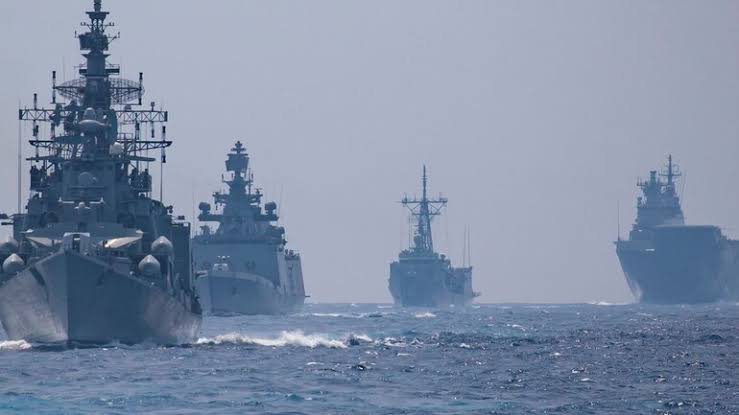China’s Underwater drones carrying out underwater recce in Indonesian waters

Dated : 12 Jan 2021 (IST)
China’s expansionist activities in the disputed Seas off Chinese Southern Coast, extensive oceanographic research in Indo Pacific region and increasing forays in the Indian Ocean Region are believed to be for military purposes. They are increasingly becoming a concern for all other seafaring nations.
Recently Indonesian fishermen found an underwater drone near Selayar Island in Indonesia’s Flores Sea which according to experts was a Chinese Sea Wing unmanned underwater vehicle (UUV).
This UUV found near Selayar Island, points to Beijing’s active surveillance of shipping lanes in Indonesian waters.
These are also the only deep-water channels that connect the South China Sea to the strategic Indian Ocean, which also becomes a concern for India.
Beijing claims rights to parts of the Nautuna sea overlapping Indonesia’s exclusive economic zone (EEZ). The other significant point is that these waters are also close to critical shipping lanes linked to the north of Western Australia.
These are waters through which oil tankers from the Middle East carry oil to China. These are also waters through which Singaporean refined fuels flow to Australia.
In March 2019, a similar UUV was found in the world’s busiest shipping lane of the Strait of Malacca between Indonesia and Singapore. The next drone was found on January 2020 near the Sunda Islands belonging to southern Indonesia and the latest one on December 20, 2020, has been found in the Lombok Strait of Indonesia (a strait connecting the Java Sea to the Indian Ocean).
These drones come packed with multiple sensors and long-range transmitters to relay recorded data back to the monitoring stations in order to gather vital information for their navy submarines.
These drones are mostly unpowered and work on a principle called as the “variable-buoyancy propulsion”. This is a mechanism where a balloon-like device filled with pressurised oil inflates and deflates repeatedly. This causes the device to sink and rise, thereby moving forward with the help of the wing-like structures.
The Indonesian media has released the dimensions of the captured drone: It is 225cm in length having a 50cm wingspan and a 93cm-long trailing antenna.
Underwater drones like these are manufactured by nations like the USA, China, France and a few others. Naval experts, however, feel that the captured drone carries certain character features that shows it is a Chinese-manufactured device.
The sensors can gather data ranging from temperature, turbidity, salinity, chlorophyll and oxygen levels. This data can be valuable to naval planners supporting submarine operations and can be vital to enable hiding of submarine movements from the enemy’s eyes.
Sea Wing can carry conductivity, temperature, depth (CTD) sensors, as well as turbulence meter, turbidimeter, chlorophyll sensor, dissolved oxygen sensor, nitrate and other biochemical sensors. It can also carry acoustic sensors such as ADCP (acoustic doppler current profile), underwater acoustic communication and hydrophones. These UUVs can play different roles such as scientific research, dynamic ocean process observation, acoustic detection, comprehensive exploration of the deep-sea environment. Naturally, these have naval/military relevance and are helpful in civilian research.
The Selayar Island where the drone was found is situated to the north of Western Australia. The Sunda Strait that is nearby is a deep-water channel leading to the Indian Ocean. The Lombok Strait on the other side links Indonesian to the Timor Sea and Darwin (Australia).
The captured underwater drone has now been taken to Indonesia’s Makassar naval base for inspection. Military analysts speculate that such drones can act as submarine hunters, capable of locating, identifying, following, photographing and targeting underwater opponents.
“Perhaps this latest discovery is significant because it is reported that the drone was active when the fishermen found it: it was moving, the light was blinking, and the forward sensors were working. And this is the first time we have heard that the military publicly say they have secured the drone and are conducting a full investigation which, according to the latest report, is currently being carried out in the second fleet headquarters of the Indonesian navy in Surabaya.”
It is noteworthy to revisit that China’s Academy of Sciences had stated in December 2019 that it had released a dozen of such Sea Wing drones into the Indian Ocean.
These underwater drones reportedly travelled around 12,000km and dove up to 6.5km beneath the wavetops.
Beijing’s covert surveying of the underwater terrain in these choked waterways is indeed alarming for nations in the region. Australia especially may feel uncomfortable considering the already escalating trade and diplomatic tensions between China and Australia.
These underwater drones can map every nook, cranny and wreck on the sea bottom, and can also chart changes in water temperature, salinity and current speed.
Such hydrographic data is vital for submarine warfare both for friendly submarines to remain hidden and to help locate hostile ones. It can also identify the most effective locations to position sea mines to attack ships passing overhead. These routes, the Sunda Strait and Lombok Strait, may be important in wartime.
“Intelligence gathered by the drone may be valuable to the Chinese Navy if their submarines intend to use these straits,” Sutton said.
Beijing has been repeatedly caught operating in foreign waters in the past. In September 2020, the Indian Navy had evicted a Chinese survey ship Shhiyan-1 from the waters surrounding the Andaman and Nicobar Islands. It is recorded that Beijing has been sending regular submarine patrols around the waters of the Andamans and Bay of Bengal since 2012.
Experts said such recces could also be a result of fears within the Chinese establishment of other naval powerhouses in the region (starting with Quad or the grouping of India, Australia, the US and Japan) as China’s economy relies heavily on sea lanes of communication passing through these waterways. On the other side, controlling these channels could help stifle countries like Japan, Australia and South Korea in the future, if a situation arose.




